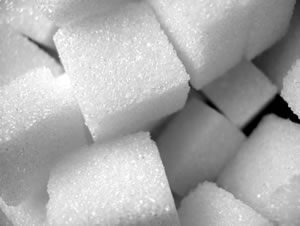 If I had to choose the biggest culprit in nutrition related health problems today, it would be sugar. Seemingly unrelated health issues such as mood swings, sleep deprivation, belly fat, skin problems, heart disease, arthritis and many more have been scientifically linked to the excess consumption of this sweet, white powder. And most of us don’t realize how much of it we (and even more importantly our children) are consuming. Or the effect it has on our bodies and our minds.
If I had to choose the biggest culprit in nutrition related health problems today, it would be sugar. Seemingly unrelated health issues such as mood swings, sleep deprivation, belly fat, skin problems, heart disease, arthritis and many more have been scientifically linked to the excess consumption of this sweet, white powder. And most of us don’t realize how much of it we (and even more importantly our children) are consuming. Or the effect it has on our bodies and our minds.
My own health quest started about 8 years ago and over those years, while I cleaned up my diet and began understanding what worked for me and what didn’t, I saw great improvement in my physical well being. But it wasn’t until I, at the advice of my Alternative Medicine Practitioner, removed sugar from my diet altogether that I felt remarkably better. And after all those years I thought I had a pretty good understanding of what a healthy way of eating was! The process wasn’t easy because, although I wasn’t exactly a sugar “junkie”, I did have a sweet tooth. It wasn’t easy because sugar is almost everywhere and it is addictive. It triggers dopamine, a chemical that controls pleasure in the brain.
Ever since I have tried to get my children on board, which is even harder, but when they managed to stay away from sugar even they saw so many improvements. My younger son’s grades went up, he slept better and was far less hyper. My older son became stronger, increased his stamina which propelled his football game to new levels.
Given the apparent link between sugar and health I spent a good amount of time researching and trying to understand why sugar consumption causes all these problems. In this article I will try to explain what I found, what the possible implications of a high sugar diet are and I will give some tips on what to do to limit the harmful effects of sugar consumption.
The link between sugar consumption and health
In our daily diets we eat a combination of macronutrients, which are carbohydrates, proteins and fats. Carbohydrates are generally considered to be the most important source of energy for our bodies. Once we eat a carbohydrate, be it bread, rice, fruit, vegetable or pasta, it gets converted in our body into a simple source of sugar called glucose.
Glucose is a source of energy but in large excess amounts in our bloodstream it is toxic so the body has a way to get it out of our bloodstream quickly and store it in our cells. This is done with the help of insulin, a hormone released by the pancreas that helps move glucose into the liver and muscles where it is stored as glycogen for future energy requirements.
This system worked perfectly well 10,000 or more years ago when our ancestors consumed 80 grams of carbohydrates daily. There was no agriculture, therefore no grains, and fruits and vegetables were limited. Our “hunter-gatherer” ancestors survived (and thrived) on a diet which largely consisted of proteins and fats. Today we consume in the range of 350 to 600 grams of carbohydrates per day and most importantly, a large portion of that is made up of high sugar, refined, processed foods. Our bodies are simply not made to process such an overload of sugar. It interferes with our hormones, especially insulin. Once the liver and muscle cells are filled with glycogen, they become resistant to the “call” of insulin. Continuing high levels of glucose in our bloodstream lead to the pancreas’ release of even more insulin which in turn leads to even more resistance in the cells. Eventually the excess glucose in the bloodstream is converted into fat.
So we are looking at weight gain, insulin resistance, which leads to leptin resistance. This means our brain will no longer “hear” the signal of the hormone leptin that we have enough fat stored and can stop eating and start moving. As a result we eat even more and continue to add fuel to fire. High, toxic levels of glucose as well as high levels of insulin eventually lead to the formation of Advance Glycation End products (AGEs) which clog our arteries, cause systemic inflammation and deposit in joints to make them stiff. Once the liver becomes insulin resistant it can’t convert thyroid hormones T4 into T3 so we have thyroid issues to boot. We are looking at hormonal imbalances, weight gain, heart disease, cancer, and so on and so forth.
And that is not the end of this story. To make matters worse we have High Fructose Corn Syrup (HFCS), a corn derived cheap form of sweetener which is found in almost everything from soft drinks, condiments to breads. Dr. Robert H. Lustig, a pediatric endocrinologist at the university of California and a leading expert on childhood obesity, calls it the most widespread legal form of drug available today. Both HFCS and regular table sugar (sucrose) are part glucose and part fructose. Fructose is literally a toxin to our bodies. Around 30% of fructose is metabolized in our bodies as fat, it has been linked to learning and memory problems, Metabolic Syndrome, higher levels of cholesterol (the bad kind) and more. In his lecture “Sugar – The Bitter Truth” Dr. Robert H. Lustig explains in detail why fructose is toxic to our bodies. You can listen to it on YouTube.
How do we limit sugar’s harmful effects?
So here we are: our carbohydrate consumption has increased to excessively high levels and a large portion of that consists of toxins. Add to that our sedentary lifestyles and it is no wonder that we are dealing with a whole host of health problems. But it is not too late to make changes and transform your health. With a little bit of willpower, support and certain lifestyle changes you can successfully reduce sugar’s harmful effects. Here are some tricks and tips:
1. Limit your sugar intake
* Reduce carbohydrate consumption. Unlike popular belief we can get all the carbohydrates we need from fruits and vegetables. Add to that high quality protein and good fats and you have a very well balanced diet with plenty of fuel for your body. Check out my article on Paleo Lifestyle for more information on eating a low carbohydrate diet. If you do include carbohydrates in your diet in the form of grains, choose the whole grain option (see tip 2).
* eliminate from your diet the refined, processed, high sugar kinds such as soft drinks, fruit juices, candy, biscuits, ice cream, white bread, etc and be extra wary of products containing HFCS and high amounts of sugar. Instead, choose whole, fresh foods that include good fats and protein. This will cover all your nutrient needs and make you feel satisfied longer. Try eating nuts for a snack or (dried) fruits, smoothies and raw vegetables with a dip. Check out my recipes for smoothies and some delicious, healthy snacks.
* skip dessert or eat fresh fruit to satisfy your sweet tooth. Although fruits are high in naturally occurring fructose they contain fiber (the natural antidote to sugar – see tip 2) as well as important nutrients and antioxidants.
2. Increase your fiber intake.
* Fiber is a natural antidote to sugar. Fiber increases satiety and reduces the intestinal rate of carbohydrate absorption. This is the reason that whole fruits are good for you despite naturally occurring fructose. Nature takes care of itself. It is the processed, un-natural foods that cause the problems.
* fiber also inhibits the absorption of some free fatty acids. These free fatty acids are then metabolized by bacteria in the colon into Short Chain Fatty Acids which suppress insulin.
* High fiber foods are whole grains, fruits and vegetables, beans and nuts.
3. Get moving.
* During and after exercise muscles burn the stored glycogen, making room for more. In the process insulin receptors are up-regulated making them more sensitive to insulin and ready to move glucose into cells.
* Exercise reduces stress and lowers cortisol levels. High levels of cortisol contribute to insulin resistance so you want to keep your stress levels in check. Physical movement also helps detoxify fructose, improving hepatic insulin sensitivity.
* Do yoga, walk, go to the gym, dance, play! Move. Every day. It really is non-negotiable. Our bodies are meant to move. Not to sit around all day long behind a desk or on a sofa. Find a type of exercise that suits you and incorporate it into your daily routine. Check out my article Move! for tips.
4. Include omega 3 fatty acids in your diet
* omega 3 Fatty Acids will protect against damage caused by sugar to the synapses: the chemical connections between brain cells that enable memory and learning. Check out the following article for more details: http://www.sciencedaily.com/releases/2012/05/120515150938.htm
* omega 3 fatty acids are not made by the body and need to be obtained from our diet. The best natural source of omega 3 is fatty fish, such as salmon, sardines, mackerel. Vegetarian sources are flax seeds, chia seeds, hemp seeds and walnuts.
* take a supplement. There are so many benefits associated with the consumption of omega 3 fatty acids that it is worth your while making sure it is a part of your diet. A supplement will make sure you consume it daily even if you don’t eat fish, walnuts etc. Supplements are mostly in the form of fish oil, cod liver oil, flax seed oil.
For more interesting reading on sugar visit the following article written by Gary Taubes, an independent science writer and journalist and author of “Why We Get Fat”: http://www.nytimes.com/2011/04/17/magazine/mag-17Sugar-t.html?pagewanted=all&_r=0


